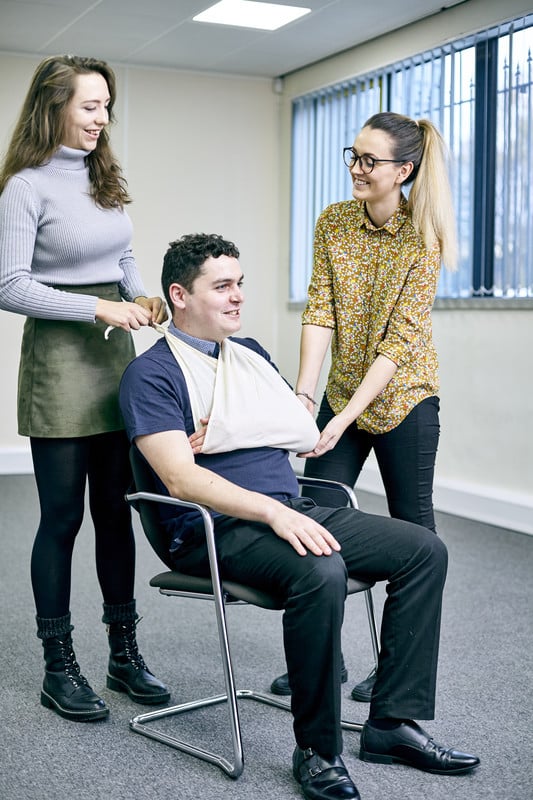What is a hybrid workplace and will it continue?
Hybrid working combines elements of both remote work and traditional in-office work. Hybrid workers have a certain amount of flexibility to divide their working hours between their employer’s premises and a remote location, usually their home.
While hybrid working has many benefits, it does have an impact on first aid provision. In particular, when varying numbers of employees are working remotely, it is not always possible to know who is onsite. This means employers need to find ways of ensuring there are always sufficient numbers of trained first aiders in the workplace, as well as making sure hybrid workers have access to some form of first aid provision.
It appears that hybrid working is here to stay. A recent report by the British Chambers of Commerce (BCC) found that only 27 per cent of organisations expected their employees to be physically present full time over the next five years, whilst 16 per cent expected mostly remote working and 8 per cent expected fully remote working.
What are the challenges of hybrid working and how does it affect the provision of first aid?
In hybrid workplaces, employees split their time between remote work and the office. This can lead to fewer first aiders physically present on-site at any given time. If this happens, it could result in delayed response times during emergencies because fewer trained individuals are available to provide immediate first aid assistance.
Employers can manage this challenge by training additional first aiders and operating a rota system for hybrid workplaces that ensures enough first aiders are always onsite. Our blog on how many first aiders are required for a workplace can help you get this right and consider other factors such as employee absence, shift working and breaks during the working day.
How does hybrid working impact a first and needs assessment?
Hybrid working can significantly impact first aid provision. Without action, it can mean that there are insufficient first aiders available in a workplace. It can also lead to communication challenges, reduced supervision and support as well as issues with psychological wellbeing.
It is essential in hybrid workplaces to revisit your first aid needs assessment. Hybrid working brings with it a risk that response times can be extended or that there is no first aider available in an emergency.
It will also allow you to update your first aid policies and procedures to include guidelines specific to hybrid working arrangements, helping to ensure you continue to comply with the requirements of the Health and Safety (First-aid) regulations 1981.
How should workplace emergencies be planned for?
Hybrid workplaces should have clear and effective emergency procedures and plans in place is crucial for managing various situations. These plans should outline the steps to be taken in the event of an accident or medical emergency, including who to contact, how to evacuate the premises if necessary and where to assemble for a headcount. Regular drills and practising of emergency procedures can help ensure that everyone knows what to do during an unforeseen incident.
It is possible that you will need to provide safety signs and signals to meet your obligations. The Health & Safety (Safety Signs and Signals) Regulations 1996 define these as things like ‘no entry’ signs, acoustic signals such as sirens and pre-recorded evacuation messages.
As a minimum, you must provide safety signs and signals where other methods cannot deal effectively with certain risks, or where using a sign can reduce the risk further.
What factors should be considered for first aid provision?
Your first aid risk assessment needs to focus on the specific conditions of your working environment, your workforce and any hazards and risks that may be present.
The Health and Safety Executive recommends you consider the following factors:
- The nature of the work and workplace hazards and risks.
- The nature of the workforce.
- The organisation’s history of accidents.
- The size of the organisation.
- The needs of travelling, remote and lone workers.
- Work patterns.
- The distribution of the workforce.
- The remoteness of the site from emergency medical services.
- Employees working on shared or multi-occupied sites.
- Annual leave and other absences of first aiders and appointed persons.
- First-aid provision for non-employees.
Can a hybrid worker also be a first aider?
Anyone can learn the skills and gain the confidence to save a life through a first aid course. Hybrid workplaces will often require more workers to receive first aid at work training, as rotas can make it difficult to ensure you have a qualified first aider on site at any given time.
If you find you do need additional first aiders, 1-day Emergency First Aid at Work training equips people with the skills and knowledge they need to treat a wide variety of injuries and medical conditions. A 3-day First Aid at Work course gives learners more in-depth knowledge that is suited to higher-risk environments.
Topics: First Aid



